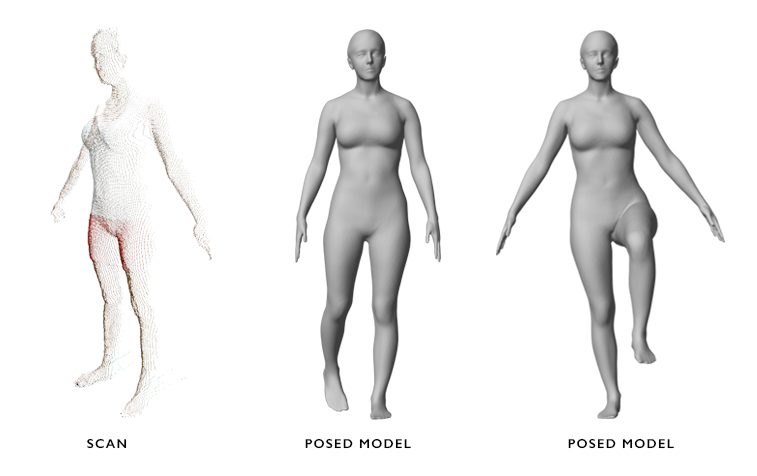
January 9, 2015 The ABC’s of Avatars
OUR MISSION
At Body Labs, our mission is to digitize and organize all the information about a human body’s shape, size, and pose.
We see the digital body model as a platform – literally an object upon and around which goods and services are created and acquired.
We believe the human body will be the next important interface between businesses and consumers.
We envision a world in which all consumers have digital body models to use as part of their online identities. With these body models, people can have custom products made for them, or match their body models to find the best-fitting or most appropriate goods or services for their size, shape or preference.
SO….WHAT EXACTLY IS A 3D BODY MODEL?
A 3D body model, or avatar, is a digital manifestation of a person. It’s more than an image created by an illustrator or a point cloud from a scanner – it is a 3D form that’s not only accurately shaped like a human body, but it can also pose and move exactly like a human being would. In addition, inherent in the model are other human body dynamics, such as soft tissue characteristics (i.e., fat or muscle) and breathing. It is, in total, a digital “you.”
See the following table for comparisons between the properties of a scan and a body model:
A Scan versus a Body Model
| SCAN | BODY MODEL |
| Extract measurements | Extract measurements |
| Soft tissue deformations | |
| Pose | |
| Animate | |
| Dress within CAD programs | |
| Compare |
A SCAN ≠ A BODY MODEL
While full body scans do look like exact replicas of their subjects, it’s very important to note that the computer does not “see” this scan as a human body. The critical fact is that a scan is not a body model. A scan is just a collection of points; and as such, all the computer sees and understands are points.
However, Body Labs makes a scan useful by creating from it a 3D avatar, which can then be understood by a computer as a body. With a body model, the computer “sees” where this body’s knees are and identifies the avatar’s shoulder as a shoulder. As a result, the model can be measured like a body; posed and animated like a body; and, with CAD software, dressed and manipulated as a body. In addition to making body models from scans, we can also generate models from measurements — from as few as several measurements to even hundreds.
DIDN’T BODY MODELS ALREADY EXIST?
Traditionally, creating a body model has been the domain of graphic artists and professional animators. Hand-crafted computer designs and extensive manual animation can accurately capture shape and movement. But, the expert attention and attendant cost inherent in this process has kept body models in the realm of Hollywood and professional video game design. Now, advances in computer vision have made it possible to efficiently, accurately, and economically produce avatars for every individual.
HOW DO WE DO IT?
At Body Labs, we use the most sophisticated statistical understanding of human shape and pose to create highly accurate body models. Our technology is based on almost a decade of research and incorporates thousands of scans and measurements of thousands of individuals in thousands of poses. This gives us a thorough understanding of how shape and pose vary, independent of each other. We can put any body, in any pose. And, we can animate any body across the full breadth of human motion. In short, we have the world’s most comprehensive statistical analysis of the human body.
And from this data we’ve built a set of algorithms that enables anyone to input measurements or a 3D full-body scan and get back a 3D avatar of that person.
For more technical details visit: http://ps.is.tuebingen.mpg.de/project/3D_Mesh_Registration
We look forward to sharing more information on how our body models came to be and the applications being developed around them. Stay tuned for more in the coming months!